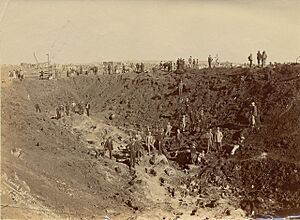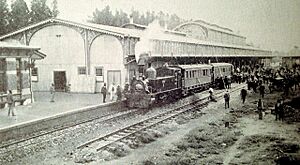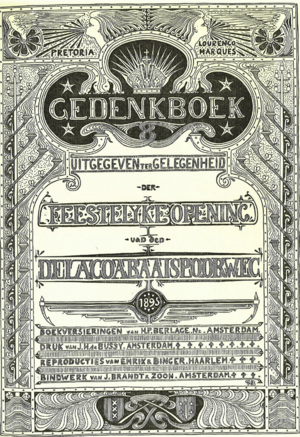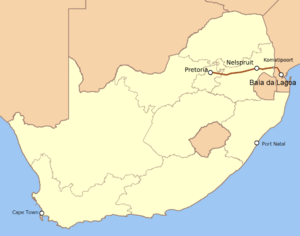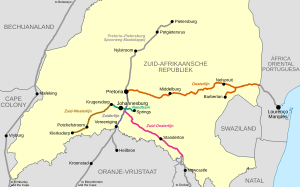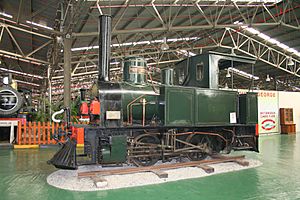Netherlands–South African Railway Company facts for kids
| Info | |
|---|---|
| Main {{{nameforarea}}}(s): | Southern Africa |
| Stations called at: | From Pretoria - Lourenço Marques to Pretoria - Johannesburg Company |
| Listed Company | |
| Headquarters | |
|
Number of employees
|
ca. 1500 Dutch employees; an unknown number of South African employees |
| Technical | |
| Track length: | ca. 1147 km |
| Gauge: | 1,067 mm (3 ft 6 in) |
The Netherlands–South African Railway Company, often called NZASM, was a railway company started in 1887. It was based in Amsterdam, Netherlands, and Pretoria, South Africa. The company built and ran railways in the South African Republic (ZAR) in the late 1800s. The ZAR's president, Paul Kruger, asked NZASM to build a very important railway line. This line connected Pretoria to Lourenço Marques (now Maputo) in Mozambique.
Contents
Why Was a Railway Needed?
A New Home for the Boers
In 1806, the British took over the Dutch Cape Colony in South Africa. Many Dutch colonists, known as Boers, did not like the new British rule. So, in the 1830s, thousands of Boers moved inland. This big move was called the Great Trek. They created 14 independent republics. By the mid-1800s, these republics joined together. They formed two larger ones: the South African Republic (ZAR) and the Orange Free State. The British Empire finally said these republics were independent in 1852 and 1854.
Tensions and the Need for Trade
The relationship between the British and the Boers was often difficult. This was especially true after the First Boer War (1880–81). Both Boer republics were located far from the coast. To reach the ocean, they had to go through British-controlled areas. These areas included the Cape Colony and the Colony of Natal.
President Paul Kruger of the ZAR wanted a different way to reach the sea. He thought it was very important for his country. After 1886, a lot of gold was found in the Witwatersrand area. This "Gold Rush" made the ZAR grow very quickly. It also made getting to the ocean even more important. The ZAR suddenly had a lot of money. This allowed them to build big projects like railways.
Building the Railway Company
Starting the Project
Back in 1874, the ZAR government decided to build a railway. It would connect the ZAR to Lourenço Marques on Delagoa Bay in Portuguese East Africa. A group was set up to plan this railway. They had some early success. They raised money and got permission from the Portuguese government. But then the First Boer War started, and the project stopped.
After the war ended in 1881, the railway project started again. Everyone was even more excited about it. They wanted to avoid the British controlling their trade. In 1884, a group of Dutch investors got permission to build the railway.
NZASM is Born!
The Netherlands–South African Railway Company (NZASM) was officially started on June 21, 1887. This happened in Amsterdam, Netherlands. The company got money from investors in the Netherlands, Germany, and from the Boers themselves.
The railway line from Pretoria to Delagoa Bay was 562 kilometers (about 350 miles) long. It opened on November 6, 1894. This line is still used today! The railway company hired about 3,000 people. About 1,500 of them worked on building this main line. The railway used the same track width, called Cape Gauge, as the nearby Cape Government Railways.
A Big Explosion
On February 19, 1896, a train carrying dynamite was hit by another train. This happened while the dynamite was being unloaded. The accident caused a huge explosion in Braamfontein. It was one of the biggest non-nuclear explosions ever made by humans. More than 70 people died, and 200 were hurt.
Johannesburg's Special Station
In 1897, a new train station was built in Johannesburg. This building was actually built in 1895 in Rotterdam, Netherlands. It was used for an exhibition in Amsterdam. Then, it was taken apart and shipped to Johannesburg. It was put back together there in 1897. The Johannesburg Park Station has been rebuilt twice since then. But the original 1897 building was saved! It was moved a short distance to Newtown. It is still there today, though it is not used.
By 1899, NZASM had built 1147 kilometers (about 712 miles) of railway lines.
Important Railway Lines
The Randtram Line
The goldfields in Witwatersrand grew very fast in the 1880s. There was a big need for coal for the growing industries. So, on July 20, 1888, the ZAR government allowed NZASM to build a 16-mile (26 km) railway line. This line went from Johannesburg to Boksburg. It opened on March 17, 1890. The first train was pulled by a "14 Tonner" locomotive. This line was called the "Randtram." Even though it was a full railway, not just for trams, the name stuck. It was the first working railway line in the Transvaal area.
The next year, the line was made longer. It went east to Springs, where coal was found. It also went west through Roodepoort to Krugersdorp. The whole 49-mile (79 km) line opened on February 10, 1891.
NZASM used special steam locomotives for the Randtram line. They were called "10 Tonners" and "14 Tonners" because of their weight. The first locomotive, named Transvaal, started working on July 18, 1889. It pulled the very first train on the Randtram line. It was retired in 1903 after traveling over 113,309 miles (182,353 km)! By 1899, the Randtram Line was 82 kilometers (about 51 miles) long.
The Pretoria–Delagoa Bay Line (Oosterlijn)
Having a railway to a harbor was a long-time dream. President F.T. Burgers had suggested a line from Delagoa Bay to Pretoria back in 1872. The Portuguese government liked the idea. It would open a trade route from their land into the interior. In 1883, Major Joachim Machado explored a route. He suggested going through the Komati River and Crocodile River valleys. The plan was for Portugal to build the part from Delagoa Bay to the border at Komatipoort. The ZAR would build the rest to Pretoria.
The Portuguese line reached the border on December 14, 1887. But the first train from Delagoa Bay only arrived at Komatipoort on July 1, 1891. This was when NZASM finished the bridge over the Komati River. The line continued to Nelspruit by June 20, 1892. It reached Waterval Boven by June 20, 1894. Finally, it connected with the line from Pretoria at Balmoral on October 20, 1894.
Building this railway was very hard. Many workers died from malaria. The land was also very mountainous. In one area, the Elandspruit Valley, there was a 295-foot (90 m) waterfall. The cliffs there made it very difficult to continue the railway.
Climbing the Mountain
The hardest part of the construction was climbing up the steep mountain slope. The builders had two choices. They could make a very long detour with many curves and expensive tunnels. Or, they could build a shorter, steeper section. This shorter path would have a very steep slope (1 in 20, or 5%) for about 2.1 miles (3.4 km). It would also need a 233-yard (213 m) tunnel.
They chose the shorter, steeper route. To make it safe for trains, they added a special "rack track" system. This system, called Riggenbach, was used on mountain railways in Europe. The rack track was placed between the regular rails.
The entire line, also known as the Oosterlijn (East Line), was 562 kilometers (about 350 miles) long. The NZASM controlled 472 kilometers (about 293 miles) of it. The main stops on the line were:
- Pretoria (start)
- Bronkhorstspruit
- East Rand
- Middelburg
- Waterval Boven
- Nelspruit
- Komatipoort (last stop in South Africa)
Border crossing between South Africa and Mozambique
- Ressano Garcia (first stop in Mozambique)
- Moamba
- Lourenço Marques (now Maputo)
- Maputo Bay - (end)
The line officially opened on January 1, 1895. Today, it runs through the Gauteng and Mpumalanga provinces of South Africa. These areas were once part of the ZAR. After this big line was finished, a shorter line was built between Pretoria and Johannesburg. It also used the Cape Gauge track width.
Other Important Lines
Besides the Randtram and the Pretoria–Delagoa Bay Lines, NZASM also ran four other important lines:
- The Kaapmuiden - Barberton line: This was a 55-kilometer (about 34 miles) side line off the Oosterlijn.
- The Zuiderlijn (South Line): This line was meant to connect to the Cape Colony. It ran from Pretoria to Viljoensdrift, at the border with the Orange Free State. NZASM controlled 125 kilometers (about 78 miles) of this line.
- The Zuid-Oosterlijn (Southeast Line): This line was planned to connect to the Colony of Natal. It ran from Johannesburg to Volksrust, at the border with Natal. NZASM controlled 256 kilometers (about 160 miles) of this line.
- The Zuid-Westerlijn (Southwest Line): This line was meant to connect to the Orange Free State. It ran from Krugersdorp to Klerksdorp, at the border. It was 156 kilometers (about 97 miles) long.
A short 1-kilometer track near Johannesburg connected the Zuiderlijn, Zuid-Oosterlijn, and Zuid-Westerlijn.
The Barberton Branch Line
Gold was discovered near Barberton in 1884. This meant a branch line was needed to reach the mines. Building it was very expensive because of the mountains. NZASM eventually took over the construction and finished the line in 1896.
The Zuiderlijn and Cape Connection
The Zuiderlijn was NZASM's shortest line leaving the ZAR. In 1888, the Cape Colony and Orange Free State agreed to build a railway between Port Elizabeth and Bloemfontein. The Cape government paid for it.
The Oosterlijn was being built slowly. But Johannesburg was growing fast and needed heavy mining equipment. So, in 1890, the ZAR agreed to build a line between Pretoria and the Vaal River. NZASM had money problems, and the project stalled.
Through an agreement, the Cape Colony's own railway company (CGR) built its line to Pretoria. The CGR would run the ZAR part of the line for two years. Then, NZASM would take it over. On January 1, 1893, Pretoria was connected to Cape Town and Port Elizabeth! This railway made it possible to bring in heavy machinery for gold mining and other construction.
The Zuid-Oosterlijn and Natal Connection
The Zuid-Oosterlijn was the last of NZASM's lines to connect to other railway networks and the coast. After gold was found, the Cape Colony and Natal raced to connect to the goldfields. The Natal government agreed to extend their line to the Rand. The line reached Charlestown, the last town in Natal before the ZAR border, in 1891.
President Kruger did not allow Natal's railway to enter the ZAR until the Oosterlijn to Delagoa Bay was finished. Once the Delagoa Bay line opened in 1895, Natal's railway built the 250-kilometer (155 miles) link to the NZASM network. This connection was completed by the end of 1895.
The Zuid-Westerlijn
Gold was found near Klerksdorp in 1886. So, the "Randtram" line was built between Krugersdorp and Springs. The ZAR government decided to extend this line to Klerksdorp. This extension was called the Zuid-Westerlijn. NZASM was not keen to build it because they thought it would not make money. But the ZAR government agreed to cover half the costs. Construction started in 1895. After delays, the line opened to Klerksdorp on August 3, 1897.
This line carried passengers, freight, and animals. But it lost money. In 1898, railway prices were lowered to help the gold mining industry. This made the losses even bigger. In 1905, after NZASM joined the Central South African Railways (CSAR), the Zuidwesterlijn was extended. Today, the famous Blue Train uses part of this line.
Types of Locomotives
NZASM did not use fancy names for its locomotives. They simply called them by their weight. For example, a "10-tonner."
Most of NZASM's locomotives were built in Germany. This is because the company was Dutch but had a lot of German money. Out of 258 locomotives, 249 were designed by a German company. A few were from British and Dutch makers.
When the Second Boer War started, the ZAR government took over the Pretoria-Pietersburg railway. Its British-made locomotives then came under NZASM control.
| Year | Number | NZASM Number | Configuration | NZASM Type | SAR type | Force (kN) | Force (lbf) | Manufacturer |
|---|---|---|---|---|---|---|---|---|
| 1890 | 3 | 6-8 | 0-4-0T | 10-ton | Louis Smulders & Co. | |||
| 1889 | 1 | 0-4-0T | 13-ton | 22.9 | 5,150 | Maschinenfabrik Esslingen | ||
| 1889 | 5 | 1-5 | 0-4-0T | 14-ton | 33.9 | 7,623 | Maschinenfabrik Esslingen | |
| 1890 | 6 | 9-14 | 0-6-0ST | 18-ton | 31.8 | 7,140 | Manning Wardle | |
| 1890-92 | 24 | 15-38 | 0-4-2T | 19-ton | 34.5 | 7,744 | Maschinenfabrik Esslingen, Maschinenfabriek Breda | |
| 1896-97 | 3 | ex-PPS | 0-6-0ST | 26-ton | 44 | 9,800 | Hawthorn, Leslie and Co. | |
| 1892-97 | 4 | 991-994 | 0-4-2RT | 32-ton | 120.8 | 27,154 | Maschinenfabrik Esslingen | |
| 1887 | 1 | ex-PPS | 4-6-0T | 35-ton | 41.6 | 9,354 | Nasmyth, Wilson & Company | |
| 1891-92 | 20 | 41-60 | 0-6-2T | 40-ton | 74.3 | 16,707 | Maschinenfabrik Esslingen | |
| 1893-99 | 195 | 61-237 | 0-6-4T | 46-ton | Class B | 73.8 | 16,580 | Maschinenfabrik Esslingen, Werkspoor NV |
| 1897,1900 | 6 | ex-PPS | 2-6-4T | 55-ton | Class D | 69.4 | 15,610 | Beyer, Peacock and Company |
The End of NZASM and Its Legacy
In 1899, the Second Boer War (1899–1902) began. The ZAR government took control of NZASM. Towards the end of the war, the British military took control of NZASM and the Orange Free State's railway company. In 1904, these two companies joined to form the Central South African Railways.
NZASM officially closed down in 1908. Its shareholders were paid back for their losses. The money left over was used to start a new organization in 1908. This organization, called ZASM, works to strengthen cultural and economic ties between the Netherlands and South Africa. ZASM bought a building in Amsterdam to keep NZASM's old records. This building is now called Zuid-Afrikahuis (South Africa House).
Many of NZASM's old railway structures still exist today. These include bridges, drains, houses, and stations. Many are still used by Transnet, South Africa's current railway company. Some NZASM locomotives have also been saved. You can see them at the Outeniqua Transport Museum.
In 1916, all the railway companies in South Africa joined together. This created the South African Rail and Harbour Administration. Later, it was renamed Spoornet in 1980, and then Transnet in 1990.
You can find NZASM's old records in archives in South Africa, the Netherlands, and the United Kingdom. Many photos from NZASM's collection have been put online for everyone to see.
See also
- History of rail transport in Mozambique
- List of NZASM locomotives
- Rail transport in South Africa


